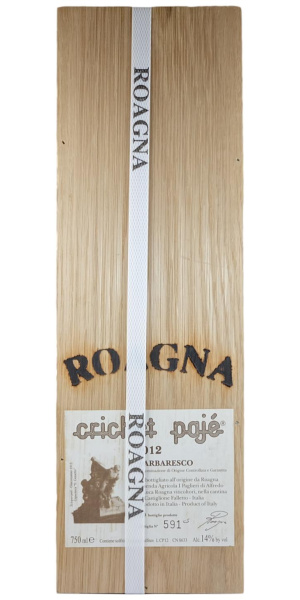The fine estate of Roagna has long roots in the commune of Barbaresco, having been started very early in the twentieth century by Vincenzo Roagna. Vincenzo passed on the reigns to his son Giovanni Roagna, who in his turn saw his son Alfredo succeed him as the head of the estate. Today the property is run by the fifth generation of the family, Luca Roagna. Luca was born in 1980, and succeeded to the winemaking for the property soon after his graduation from oenological school in 2001. The style of the estate’s wines has been consistently safeguarded down through all five generations of Roagna family members who have steered the property, with the wines made in a very traditional and classic style. These are deep, complex and structured wines that are built to age and handsomely reward cellaring.
‘The 2012 Barbaresco Crichët Pajè is tight and not especially expressive today. In this vintage, the Crichët Pajè is a bit more floral and lighter in structure than it can be. Imagine Burgundy with Nebbiolo acids and tannins. Among other things, that means the 2012 will drink well with minimal cellaring, in relative terms for this bottling. Despite its reticence, the 2012 is also restrained and so nuanced. I can’t wait to see how it develops in bottle.’ – 94+ points Antonio Galloni, Vinous
Winery notes
The name Crichet Pajé comes from the Piemontese dialect. When the Italian State was created, each parcel of land was given an official name.
The word Crichet is translated as “top of the small hill”. This is our ultimate location for the cultivation of Nebbiolo. The Nebbiolo grape performs best when it is well exposed as well as sheltered from the strongest winds from the tallest hills; Pajé term refers to the vineyard location.
Crichet Pajé is a micro parcel located within the same area, which is particularly rich in white calcareous soil and has our highest content of active limestone. The Paje vineyard is 0.5 Hectare (1.24 Acres) with a unique microclimate and soil which enjoys a view over the Tanaro river valley. The exposition mitigates the cold winters and hot summers. The vineyard is located in the center of the Pajé designated area with additional area facing Southwest.
The youngest vines used for this wine are more than 60 years-old with all vines regenerated by using clippings from other vines exclusively located within the same area.In fact, some of the vines have been propagated by using ungrafted vines. The older vines have reached a balance of optimum production even though some plants produce only a single cluster during some years.
This wine is born from the experience over many years by Giovanni Roagna.After purchasing the vineyard in 1953, Giovanni spent many years of experimentation in order to seletec this unique terroir. Over the years this wine was aged for as long as it needed in orer to reach maturity and the wine was saved for the family as well as used for important events.
In 1978, Alfredo Roagna decided to present Crichet Pajé to the marketplace for the first time.
Crichet Pajé requires long aging in large oak barrels and is introduced to the marketplace approximately 10 years after being harvested. Our family believes this is the ultimate expression of our cellar because we value highly complexity and longevity in our wine.
We harvest the nebbiolo fruit manually using small crates during the month of October and usually in the morning, once the fruit is perfectly ripe. We make two passes in the vineyard to select the fruit and ensure its’ integrity. Fermentation takes place for ten days and we use exclusively large wood casks thanks to our pied de cute with our indigenous yeasts. We then follow the ancient technique of maceration by splinting the submerged cap which can last for two and a half months (80-90 days).The wine is then aged in neutral oak barrels.
The production of bottles is extremely small, in some years we produce fewer than one-thousand bottles. The maximum production is just over two-thousand bottles and our larger size bottles of magnums, double magnums, and five liter bottles are even rarer still. We number each bottle.








